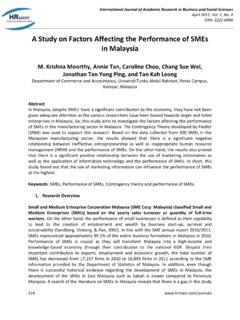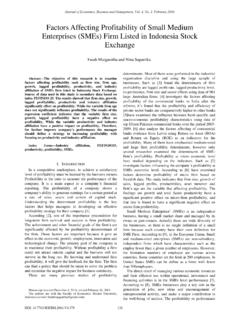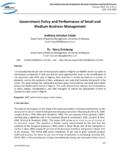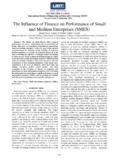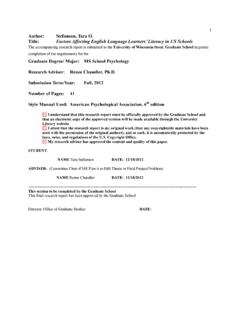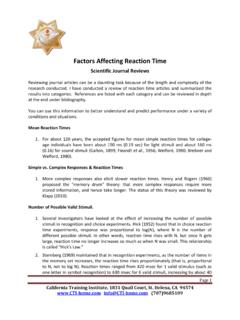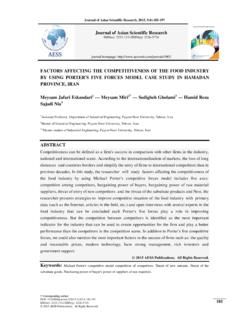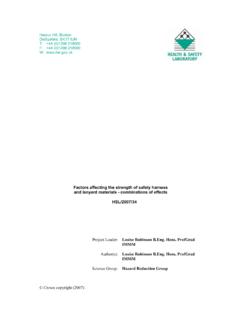Transcription of Factors Affecting the Performance of Small and Medium ...
1 IOSR Journal of Business and Management (IOSR-JBM) e-ISSN: 2278-487X, p-ISSN: 2319-7668. Volume 16, Issue 1. Ver. IV (Jan. 2014), PP 80-93 80 | Page Factors Affecting the Performance of Small and Medium Enterprises in the Jua Kali Sector In Nakuru Town, Kenya Anne Ngima Kinyua Egerton University Nakuru Town Campus College Department of Accounting, Finance and Management Science Abstract: Interest in the role of Small and Medium -sized enterprises (SMEs) in the development process continues to be in the forefront of policy debates in developing countries. The role of finance, management skills, macro-environment Factors and infrastructure have been viewed as a critical element for the Performance of Small and Medium -sized enterprises. Therefore, this study sought to evaluate the Factors Affecting the Performance of SMEs in the Jua Kali sector in Nakuru town. The study adopted a survey research design and employed a stratified random simple sampling.
2 Primary data was collected from 262 study respondents using structured data was analyzed descriptively and inferentially and presented through figures, tables and percentages. The findings indicate that; that access to finance had the potential to positively affect Performance of SMEs; management skills were found to positively and significantly affect Performance of SMEs; macro environment Factors were found to significantly affect Performance and Infrastructure did not significantly affect Performance of SMEs in the study area. The study results also indicated that as number of years in operations increased the Performance increased. The study recommends that banks should improve access to finance through offering f better lending terms and conditions and collateral requirements; focus on acquiring appropriate management skills such as financial, marketing and entrepreneurial skills and effectively strengthen the macro environment in order to increase their Performance .
3 Key words: Small and Medium -sized enterprises, Performance ,Jua kali sector I. Introduction Background of Study The Informal sector is increasingly viewed as an important engine for employment creation and economic growth. This has been necessitated by the increasing awareness within the government that large projects in the industrial sector are less likely to generate the requisite employment opportunities, given the high capital-intensity of output in the sector The role of finance has been viewed as a critical element for the Performance of Small and Medium -sized enterprises. Previous studies have highlighted the limited access to financial resources available to smaller enterprises compared to larger organizations and the consequences for their Performance and development (Levy, 1993). Typically, smaller enterprises face higher transactions costs than larger enterprises in obtaining credit (Saito and Villanueva, 1981).
4 Insufficient funding has been made available to finance working capital (Peel and Wilson, 1996). Poor management and accounting practices have hampered the ability of smaller enterprises to raise finance. Information asymmetries associated with lending to Small scale borrowers have restricted the flow of finance to smaller enterprises. In spite of these claims however, some studies show a large number of Small enterprises fail because of non-financial reasons (Liedholm, MacPherson and Chuta, 1994). Study by Tushabonwe-Kazooba, (2006) revealed that poor record keeping and lack of basic business management experience and skills are major contributors to failure of Small business. Researchers have also identified lack of access to external finance and weak capital base, inexperience in the field of business, particularly lack of technical knowledge plus inadequate managerial skills, lack of planning and lack of market research as causes of Small business failure (Lussier 1996; Murphy, Shleifer and Vishny 1996; Van Stel and Storey 2004).
5 The solution for solving problems of economic growth in developing countries often resides in the Performance of Small scale industries. It is expected that the gains to be derived from the establishment of Small -scale industries will be translated into the generation of employment at a low investment cost. The focus of the study was on the Factors which affect the Performance of Small and Medium Enterprises (SMEs) in the Jua Kali sector of Kenya, a case of Nakuru Town. The objectives of the study included; To examine the extent to which access to finance by SMEs in Jua Kali sector effects their Performance ; To examine the extent to which management skills have effect on Performance of SMEs in Jua Kali sector; To examine the extent to which macro-environment Factors have effects on the Performance of SMEs in Jua Kali sector and to examine the extent to which infrastructure have affected the Performance of SMEs in Jua Kali sector.
6 Factors Affecting The Performance Of Small And Medium Enterprises In The Jua Kali Sector In 81 | Page II. Research Hypotheses Of This Study Was; H01: Accesses to finance does not significantly affect Performance of SMEs in Jua Kali sector. H02: Management skills (Financial, Marketing and Entrepreneurial skills) do not significantly affect Performance of SMEs in Jua Kali sector. H03: Macro-environment Factors do not significantly affect Performance of SMEs in Jua Kali sector. H04: Infrastructure does not significantly affect Performance of SMEs in Jua Kali sector. III. Literature Review The term informal sector was popularized by a 1972 study of Kenya, but Kenyans have another term for the sector: Juakali, literally under the hot sun (ILO, 1972). It is indicative of the severe conditions under which micro-entrepreneurs and their employees labour. This unstructured sector has emerged as a result of the incapacity of formal, regulated industries to absorb new entrants.
7 The Jua Kali sector encompasses Small scale entrepreneurs and workers who lack access to credit, property rights, training, and good working conditions. Originally restricted to artisans, the term has come to include a number of professions, including auto mechanics and market vendors. Some studies estimate that informal businesses account for 35-50% of GDP in many developing countries. Similarly, in Kenya, the informal sector is quite large, estimated at and accounting for 77% of employment statistics .Over 60% of those working in the informal sector are the youth, aged between 18-35 years, 50% being women (Ouma et al 2009).The First 1993 Small & Medium Enterprises (SME) baseline survey revealed that there were approximately 910,000 SMEs employing up to 2 million people. The second SME baseline survey (1995), estimated the size of the SME sector at 708,000 enterprises employing up to million people.
8 Compared to the other sectors of the economy, the contribution of the SME sector to the country s Gross Domestic Product (GDP) increased from in1993 to over 18% in 1999, (Sessional Paper No. 2 of 2005). Currently, it is estimated that the contribution to the GDP by this sector stands at over 25% (Economic Survey, 2012). In Kenya, the Jua Kali as an informal sector, was traditionally run in the form of Small industries in a few African homes which mainly dealt with blacksmithing activities (Maundu 1992). The advent of the Asian community to Kenya at the turn of the last century, marked the gradual shift of 'home-based' Jua Kali activity to urbanised enterprises. Among the initial urban Jua Kali enterprises introduced were motor-mechanics, carpentry, masonry, tinsmithery and blacksmithery (Maundu 1992). With time, the indigenous Kenyans soon entered the market and gradually expanded the industry by producing a wide range of such items as jikos (braziers), cooking and frying pans, steel windows, tin lamps, motor spares and leather artefacts.
9 Today the Jua Kali industry represents an enormous conglomeration of products in many towns and villages across the Republic of Kenya. Despite the critical role played by the Small enterprise sector, it is faced with numerous challenges and constraints that include unfavorable policy, access to financial services and markets, inadequate business know-how and linkages with large enterprises, gender inequality, job quality deficits, limited access to information, impact of HIV/AIDS pandemic, unsatisfactory occupational health and safety standards. These constraints have not been well-addressed resulting in a weak base for industrial take-off and sustainable development. Nevertheless, the field of Small businesses still remains attractive because the creative enterprising individual likes to be independent and be in control of action and issuing instructions (Sessional Paper No. 2; 2005). Access to finance has been identified as a dominant constraint facing SMEs (Lader, 1996).
10 A World Bank study found that about 90% of Small enterprises surveyed stated that credit was a major constraint to new investment (Parker et al., 1995). Levy (1993) also found that, there is limited access to financial resources available to smaller enterprises compared to larger organizations and the consequences for their low growth and development. This stems from the fact that SMEs have limited access to capital markets partly due to the perception of higher risk, informational barriers, and the higher costs of intermediation for smaller firms. (Biekpe, 2004)). Previous studies have identified a growing gap in the financial support offered to Ghanaian SMEs. The high interest rates, collateral requirements and the cumbersome processes have often been mentioned as the main impediments to SMEs access to bank loans in Ghana (see Sowa et al., 1992; Aryeetey et al., 1994; Bigsten et al.










